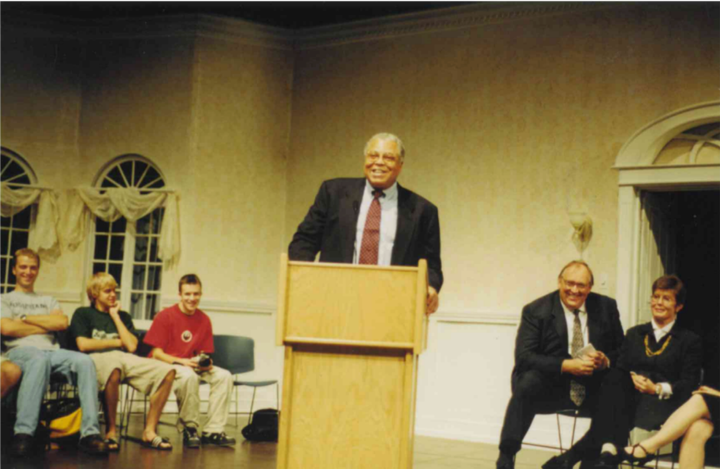Second Summit


Augustana reconsiders housing objectives, builds new apartment
JACOB KNUTSON
Flexibility and proximity are two characteristics Augustana hopes to advance in its shift in strategy on student housing, focusing on apartment-style housing instead of dormitory projects.
Included in this shift is the construction of a new $1.8 million student housing complex under the working title “Summit Avenue Apartments II,” located on Summit Avenue across from the Madsen Center.
The housing complex will offer a design similar to the original Summit Avenue Apartments, featuring eight four-bedroom apartment units for a total of 32 bedrooms.
Dean of Students Jim Bies said the new complex highlights Augustana’s new “apartment-like” approach to student housing.
“We think apartment-like housing meets the needs of more students than residence hall housing,” Bies said. “And I think as we look forward to the next 10 years, we will want to have as flexible housing as we can for students.”

Theme houses Odin and Academy and an untitled house owned by the university were leveled to make room for Summit Apartments II, which is “a better use of the land” because more beds will be available on the same amount of land, said Vice President for Finance & Administration Tom Meyer.
“We feel as though this is a really good thing to provide to students,” Meyer said. “It’s housing that’s virtually on campus but still keeps an independent apartment style.”
Bies said that the university is considering building two more housing complexes similar to Summit Avenue Apartments in the coming years, with potential sites being Costello Hall on the corner of Grange Avenue and 33rd Street and Lookout House on the corner of Summit Avenue and University Place.
Bies added that the design of the apartment complexes allows the university to build student housing while safeguarding itself from potentially overbuilding.
“If we ever found that we did overbuild, the floor design [of the apartments] would lend itself to fit offices or even housing for graduate students married with families,” Bies said. “It really is the most flexible design option for us.”
Meyer said that building apartments allows the university to “take a more cautious approach to building and not overextend” itself because they are a less expensive investment compared to a new residence hall.
Meyer estimates the cost of each apartment complex will be only a fraction of the potential $10 million it would cost to build an entrely new residence hall.
The university has also considered selling Duluth Place Apartments to reinvest funds into future apartment projects closer to campus, Meyer said.
Bies said a sale would be beneficial because Duluth Place Apartments falls outside of Augustana’s campus footprint.
“It’s a bit isolated from Augustana, and we’d like to centralize our student housing either around the perimeter of campus or directly on campus,” Bies said. “So it feels natural to explore interest with potential buyers.”
According to Bies, if a buyer emerges, the university does not plan to finalize any deal until the end of the spring semester so Augustana residents will not be dislodged. He also assumes the buyer would continue to rent to Augustana students to maintain occupancy.
Construction on Summit apartments II has been proceeding smoothly, Meyer said, but, as with many new buildings on campus, parking may become an issue for the complex.
Depending on the size and occupancy number of a building, the city requires a specific number of parking spaces to be available for each facility.
For Summit Apartments II, this requirement is an issue because parking on the southeast side of campus is already strained by the new Froiland Science Complex.
Senior Eli Yackel-Juleen, who lived in Summit Apartments last year, said he regularly had trouble finding a parking space.
“I had practicum at Lincoln High School in the afternoon,” Yackel-Juleen said. “By the time I would get back to campus later at night, it would be pretty hard to find a parking spot.”
To maximize parking, Meyer said the university plans to add parking in the alleyway behind Summit Avenue or, according to Bies, it could buy property on Norton Street to convert into parking.
“We had to address this with the Froiland, and, right now, we know that we’re feeling some [parking-related] stress—faculty are feeling stressed, students are feeling stressed,” Bies said. “There are many options open, so we’ll get it worked out.”
There will be some minor differences between Summit Apartments II and the original Summit Apartments, which Meyer said is inevitable when building.
“Every time time you build something, you can look back after a couple of years and say, ‘You know, I wish we had done something differently,’” Meyer said.
Summit Apartments II will have a different brick and exterior design than the original Summit Apartments, and, rather than having the two ranch-style apartments in the front of the complex, it will have them towards the back, Meyer said.
Junior Tara Sandgren and her roommates would like to see thicker walls.
“The common complaint I hear about is the thickness of the walls,” Sandgren said. “Right now it’s pretty easy to hear everything in other rooms.”
Completion of Summit Apartments II is set for July of 2017, and the apartments should be ready for occupancy before the 2017 fall semester.
The small construction window requires some winter construction, which is unfavorable but unavoidable when building in South Dakota, Meyer said.
“In South Dakota, you can’t just pick the months or else you’ll lose half your season,” Meyer said. “We won’t be able to do major things during winter, so we’ll just have to work on what we can.”
The university contracted Lloyd Companies, a Sioux Falls-based apartment manager and developer, to build Summit Apartments II.



